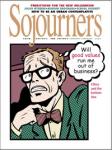Art can get messy—even in the absence of elephant dung and Mayor Giuliani. In the process of being something beautiful or profound or disturbing, art can bring together all those things we’re not supposed to talk about in polite company—religion, sex, politics, public funding. This can be a good thing. Or not. Last fall’s imbroglio over the "Sensation" exhibit at the Brooklyn Museum of Art had more to do with the cynical manipulation of free publicity (by all involved) than with the public conversation that can appropriately arise from art.
New York Mayor Rudy Giuliani surely had one eye on the points he might win from upstate Catholic voters for his senatorial campaign, as he attempted to withhold the museum’s city funding in a sudden impassioned defense of the Virgin Mary. And the museum’s director could barely contain his glee over the national publicity he was getting, even as he was decrying the city’s assault on free speech and art as a sacred untouchable.
While some clearly profited from the controversy, the rest of us benefited not at all. The general public is not now better educated on how their tax dollars (whether local or federal) are spent on the arts, nor are they better informed about how to interpret contemporary art or how arts institutions and markets interact.
The nonreligious members of the art world are not now more informed about why people of faith might be offended by certain works. Most artists will not find that the controversy increased public receptivity or comprehension of their life’s work. Most religious people will not find that it increased the public’s receptivity or comprehension of their faith.
David A. Strauss, a specialist in constitutional law at the University of Chicago, describes the questions raised by government funding for the arts as "a black hole of First Amendment law. No one really knows how to think about it, including the Supreme Court justices." Neither the constitutional questions nor the systems of funding bureaucracies will sort out quickly.
Can’t artists and believers just get along? Not all of them, not all of the time. Some in the church respect only "art" that conveys the fundamentals of Christian faith in very literal terms. Some in the artistic community view a reluctance to fund certain projects as a function of artistic ignorance and prejudice. However, in a real conversation around controversial art, even steadfastly secular artists and art-wary believers might find they have some common ground. Communication rooted in education, dialogue, and respect might very well be more effective than public policy decisions in furthering the aims of both art and religion.
Faith has inspired some of the world’s most celebrated works of art. And art has often informed and inspired a deeper spirituality. Both art and religion have helped evoke—and equip—action for a more just society. While there are sinkholes where both belief and the creative process can stumble into excess or fear, there is also a vast territory where both art and faith are called to wrestle with life’s deepest questions, seek truth, and incarnate beauty, longing, or redemption.
The manager of a college art gallery found out that the institution had been placed on a censure list by the Catholic League, who found one work of political satire involving the pope to be offensive. The league "censured" the whole exhibition without ever contacting the manager (who was Catholic), the artist (who was also Catholic), or the curators. As far as any of these parties know, no one from the Catholic League had even seen the exhibit.
Those in the faith community who find an artwork offensive are more than justified in letting a gallery or museum know it. But what principles would inform a better way for religious people to respond to art that they find to be questionable? For starters, people ought to communicate directly to the appropriate gallery or museum staff, having seen the work and gathered your facts—and do so respectfully, in the spirit of peaceful witness.
While museums that take public funds shouldn’t necessarily have to vet every component of every exhibit by government "standards of decency," museums should publicize exhibits responsibly and offer mutual educational opportunities for both the artists and the community.
Direct dialogue with artists around controversial pieces could be an interesting experiment for artists, museum curators, the religious community, and even politicians. Artists and believers have things to talk about. And it’s safe to assume that a deeper mutual understanding is impossible unless we begin to truly listen to one another.
JULIE POLTER is associate editor of Sojourners.

Got something to say about what you're reading? We value your feedback!